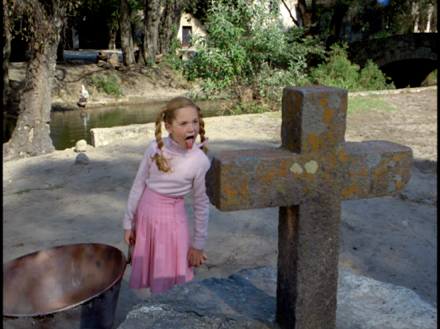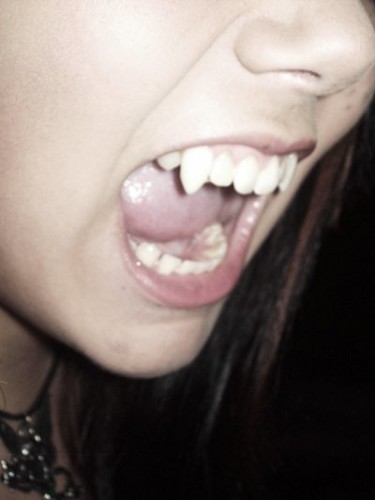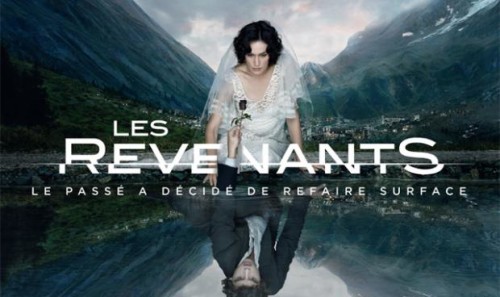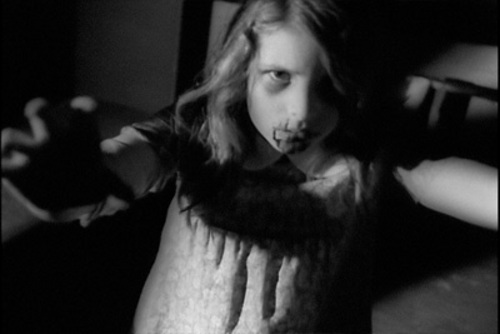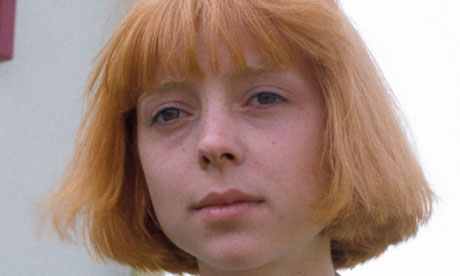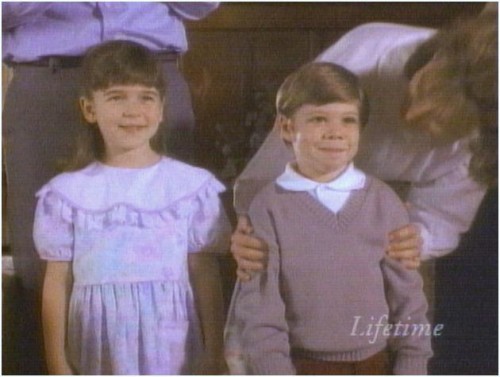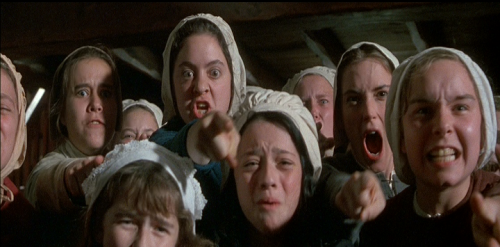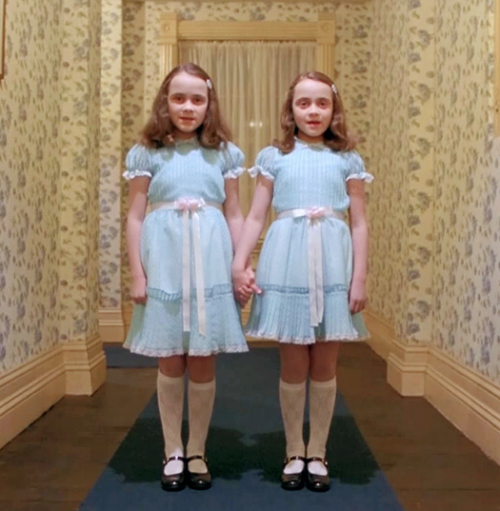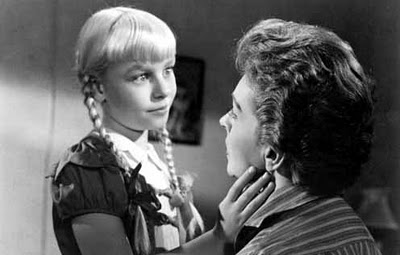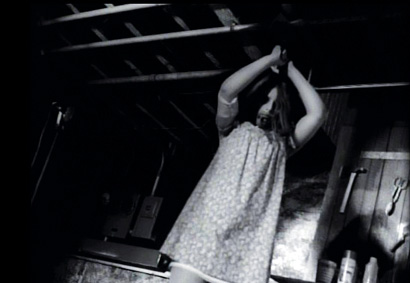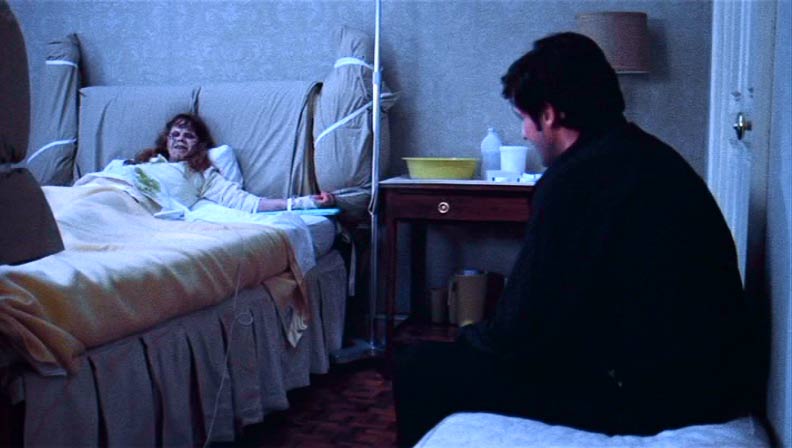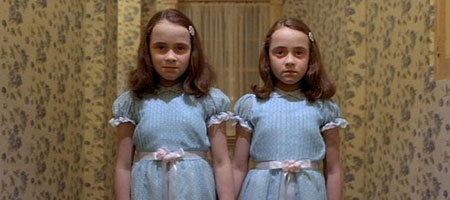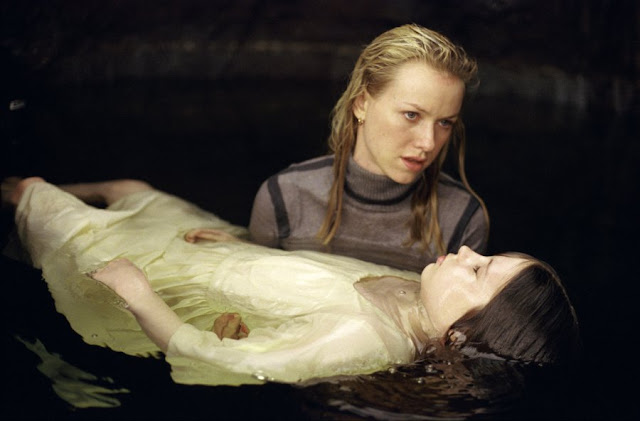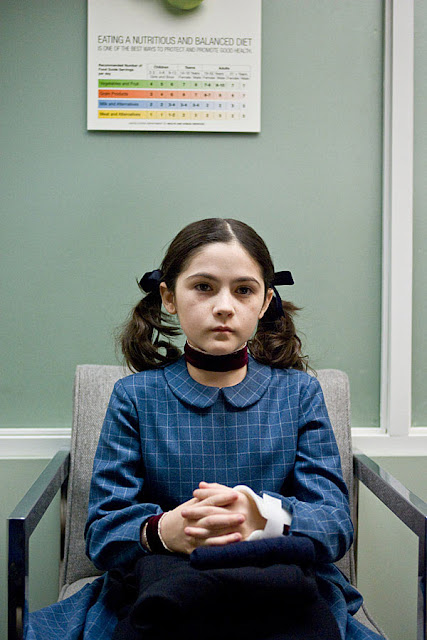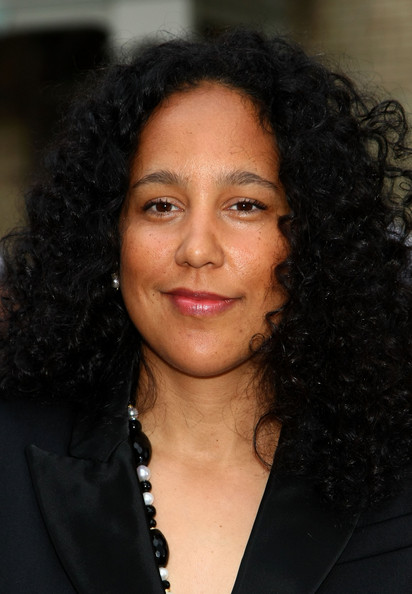This guest post by Gloria Endres de Oliveira appears as part of our theme week on The Terror of Little Girls.
What are little boys made of? / What are little boys made of?
Snips and snails / And puppy-dogs’ tails / That’s what little boys are made of.
What are little girls made of? / What are little girls made of?
Sugar and spice / And everything nice / That’s what little girls are made of.
(nursery rhyme dating from the early 19th century)

Creepy little girls in cinema and television have always been important to me; growing up as the pale, black-haired daughter of Brazilian immigrants in the suburb of an ethnically very homogenous German town instantly made me fall in love with sullen, gothic heroines such as Wednesday Addams, Lydia Deetz, and Nancy Downs (thanks to my older sister, I first saw and enjoyed The Craft at the appropriate age of 7). They looked like me, dressed like me, relentlessly pursued their own peculiar interests, and remained strong in the face of societal opposition.
As I approached my late teens, I ditched my gothy black frocks and Doc Martens and started to indulge my love for all things pink, frilly, and girly. However, this led to me experiencing an all new form of social discomfort – while before I was just looked at as plainly weird, my new stereotypically female exterior made people underestimate me in a painful way, doubting my intellectual capabilities and often even being surprised upon noticing that I, a girly girl, possessed so much as a sense of humor. Furthermore, I have experienced first hand how so-called femme-phobia can even pervade queer spaces, where femme-identified persons are often faced with exclusion. This personal background led me to be fascinated with an all new set of creepy little girls.
As Leigh Kolb notes at Bitch Flicks, ”(l)ittle girls are supposed to be the epitome of all we hold dear – innocent, sweet, submissive and gentle. The Victorian Cult of Girlhood … bleeds into the twenty-first century anti-feminist movements, and these qualities are still revered.”
Lewis Carroll described little girls thusly:
“Their innocent unconsciousness is very beautiful, and gives one a feeling of reverence, as at the presence of something sacred.”
“Artists like Charles West Cope and John Everett Millais produced dozens of domestic genre paintings with titles like The First Music Lesson (1863) and My First Sermon (1862-3), which portray the child as a bastion of simplicity, innocence, and playfulness. Women were also praised for embodying these qualities, and together with children they were urged to inhabit a separate sphere: to withdraw from the workforce, embrace their status as dependents, and provide the male breadwinner with a refuge from the dog-eat-dog capitalist world outside the family.”
These historic ideals are explored in Michael Haneke’s The White Ribbon; the director paints a haunting picture of the fictional rural German town Eichwald at the cusp of the outbreak of the First World War. The oppressive nature of this puritanical society is underscored by the local pastor, who, in his confirmation classes, instills a deep sense of fear in the children he teaches – and, if they sin in any way, makes them wear a white ribbon to remind them of the purity they should strive for.
However, this form of social shaming does not seem to prevent some of his young disciples from subverting their supposed childlike innocence: when the town is suddenly riddled by mysterious and violent crimes, it is suggested that the children have something to do with it, their leader being Klara, a 13-year-old angel-faced blonde and the pastor’s eldest daughter.

At one point, Klara is even implied to have butchered her father’s beloved parakeet with a pair of scissors. Childhood animal cruelty is not only thought to be an early symptom of psychopathic tendencies, but also stands in direct opposition to 1914 (and modern!) society’s standards for young girls – a budding mothering nature, nurturing, empathic and caring, finding release in doll and homemaking play.

The notion of female children as the pinnacle of innocence is thus subverted – but what exactly lies behind the concept of the pure, the innocent little girl? Even today, a century after the fictional happenings in The White Ribbon, purity often seems to be a euphemism for virginity and sexual inexperience, celebrated with so-called purity balls and purity rings. Just as in Victorian times and in the rural, puritanical society depicted in Haneke’s film, nowadays, women who are sexually active (outside of marriage) are still considered impure and thus abject. This notion is so prevalent and ingrained, that even women who would deny being influenced by it often dream of a white wedding, with the father of the bride leading her to the altar to basically entrust her into the husband’s custody.

A similar church ceremony is, of course, first communion – where the traditional white wedding finds it ritualistic precursor, with pre-pubescent little girls decked out in white dresses, veils and wreaths. Anne and Lore, the two 14-year-old protagonists in Joël Séria’s Mais ne nous délivrez pas du mal, who meet at a catholic boarding school set in stiflingly bourgeois 1970s France, act out by playfully, then violently processing and at the same time powerfully overthrowing what society has taught them; in a pivotal scene, the two girls stage an elaborate, candle-lit and organ-accompanied mash-up of a wedding and a communion, where they pledge everlasting allegiance to … Satan. Interestingly, the film features a screne where a pet bird belonging to an older man is killed by a one of the girls – reminiscent of Klara in The White Ribbon and her disregard for patriarchal authority.

Two little girls entangled in increasingly sinister play and satanism are also the protagonists in Carlos Taboada’s swan song Veneno para las hadas (Poison for the Fairies).
Veronica, the school’s outcast, traumatised by the death of her parents, her loneliness and the ”ridiculously inappropriate bedtime stories” her nanny tells her, befriends the new student Flavia – a wealthy, sweetly happy girl from a seemingly intact family. Veronica, a master manipulator at the ripe old age of 10, convinces Flavia that she, Veronica, is a powerful witch, enabling her to blackmail Flavia into sharing her privileges (her dolls, her happy family, her family’s summer house, even her beloved puppy) with her to an uncomfortable extent.

Scared and intimidated by Veronica’s increasingly violent displays of her supposed magical power, including the death of Flavia’s piano teacher (which was, in reality, due to a longstanding illness, not witchcraft), Flavia despairs and, at the culmination of the film, resorts to literally burning the witch: Veronica dies in a fire, the film ending with her haunting cry: “¡Flavia ayúdame!” (“Flavia, help me!”).
Behind the societal construct of the innocent little girl not only lies the imperative virginhood, but also the requirement of a certain passivity and submissiveness. Girls are taught from an early age not to be too rambunctious, not to get themselves dirty during play – femininity is thought and taught to be pristine, docile, meek and often inferior. The fact that Klara, Anne, Lore, and Veronica cannot be described as so-called tomboys is emblematic for their characters’ subversive power: They cause their violent mayhem in the frilliest, most femine dresses, decked out in candy colors, ragcurled pigtails bouncing. Perhaps this is one of the key factors that make famous cinematic creepy girls such as Wednesday Addams, Rhoda Penmark, and the Grady twins so powerful and memorable – by society’s standards, their characters’ darkness and defiance seems to exist in direct contrast to their girly exterior.

They have this in common with the Marie and Marie, the heroines in Věra Chytilová‘s Sedmikrasky (Daisies) and Alice, the protagonist in Catherine Breillat‘s directing debut Une vraie jeune fille. Those girls, wearing plenty of mascara and mini dresses, cause a range of disturbance, ranging from public masturbation to con games, theft and cake fights.
Both of these films not only pass the Bechdel Test with flying colours, but are also exclusively and intimately told from the girls’ perspectives, rendering them very modern and relevant still (which perhaps also explains Daisies‘ current popularity among girls, with stills and gifs from the film very present on all kinds of online platforms).

Another similarity between those two films (and Seria’s Mais Ne Nous Delivrez Pas du Mal) is that all three of them were immediately banned upon their release in their countries of origin. All three films depict young girls who defy any Victorian Etiquette School-style rules, who actively and independently take charge of their sexuality without any hint of submissiveness. None of these films explicitly depicts violence (no blood is ever seen on screen). The Godfather, on the other hand, a film released at a similar time, featuring a litany of violence, fist fights, gun shootings and blood baths (including a lengthy scene where a man brutally ”chastises” his wife with a belt), was not banned, neither in its country of origin, nor in France, or former Czechoslovakia. Rather, it was celebrated unanimously, winning three Oscars and is to this day held up as a cinematic masterpiece.

To me, the decade-long banning of films depicting rebellious young women demonstrates their subversive power that can be traced to the present day; as Elizabeth Kiy concludes, ”a culture’s horror stories have always reflected what they finds terrifying (…) from the fear of liberated women in Dracula to the virgin/whore dichotomy of the slasher film, and probably always will.”
Personally, I still cling to every well-written creepy heroine appearing on my screen, such as, most recently, India in Chan-wook Park’s Stoker – hopefully dismantling harmful gender stereotypes one lace-collared dress at a time, making it a little less difficult and less lonely to be a young woman.
Gloria Endres de Oliveira is a Berlin- and London-based actor, filmmaker, photographer, and writer. Updates on and samples of her work can be found on her tumblr and she twitters at @gloriayloslobos
